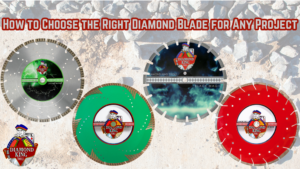Choosing the Right Diamond Blade for Your Project
When it comes to cutting through tough materials like concrete, stone, or asphalt, having the right tools is crucial. Diamond blades are the go-to choice for professionals due to their precision, durability, and speed. But with so many different types of diamond blades available, how do you choose the right one for your project?
In this guide, we’ll walk you through everything you need to know to make an informed decision.
1. What Material Are You Cutting?
The first step in selecting a diamond blade is understanding what material you’ll be cutting. Not all diamond blades are designed the same, and the material you’re working with will dictate which blade to use.
Here’s a breakdown:
– Concrete and reinforced concrete: Use a segmented diamond blade.
– Granite or stone: Opt for a turbo diamond blade.
– Asphalt or green concrete: Choose a blade with soft bonds for better cutting performance.
– Ceramic tiles: A continuous rim diamond blade is ideal for smoother cuts.
Key takeaway: Matching the blade to the material is essential for efficiency and safety.
2. Wet vs. Dry Cutting: Which Method to Use?
Diamond blades can be used for both wet and dry cutting. Knowing when to use each method is important for optimizing your tools and your results.
– Wet cutting: This method uses water to cool the blade and reduce dust. It’s ideal for jobs where heat generation and dust control are concerns, such as large projects involving concrete or masonry. Wet cutting can extend the life of your blade.
– Dry cutting: Dry cutting is more convenient for smaller jobs or when water isn’t available. However, the blade may overheat if used for long periods, so shorter, intermittent cuts are recommended.
Pro tip: If you’re unsure, wet cutting is generally the safer and more efficient choice.

3. Consider the Blade Size
Diamond blades come in a variety of sizes. Common sizes range from 4” for smaller, hand-held grinders to 14” for walk-behind saws used on large concrete slabs. Make sure you choose a blade size that is compatible with your cutting tool.
Here are some popular size recommendations:
– 4”-5” blades: Best for small tile or stone cuts.
– 7”-10” blades: Ideal for medium-sized projects like paver cutting.
– 12”-14” blades: Perfect for heavy-duty jobs like cutting concrete slabs or asphalt roads.
Remember: The blade size will also affect the depth of the cut, so choose accordingly.
4. Blade Bond: Hard or Soft?
The bond of a diamond blade refers to the material that holds the diamonds in place. The bond type affects the blade’s cutting performance on different materials.
– Hard bond: Designed for cutting soft materials like asphalt or green concrete.
– Soft bond: Ideal for cutting harder materials like granite, brick, or cured concrete.
Choosing the right bond will help improve the blade’s longevity and cutting efficiency.
5. Blade Cost vs. Longevity
When selecting a diamond blade, it’s important to balance cost with longevity. While cheaper blades may seem appealing upfront, they can wear out faster, especially when cutting tougher materials.
High-quality diamond blades are an investment, but they’ll save you time and money in the long run by providing cleaner cuts and lasting longer.
In Conclusion
Choosing the right diamond blade for your project doesn’t have to be complicated. By considering the material you’re cutting, the cutting method, blade size, bond type, and overall cost, you can select a blade that fits your needs perfectly. Whether you’re working on a small DIY project or a large commercial job, having the right blade will ensure precision, efficiency, and safety.



